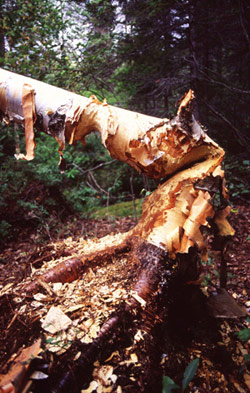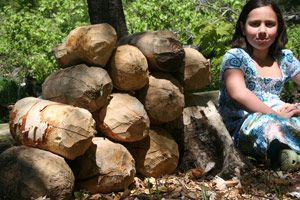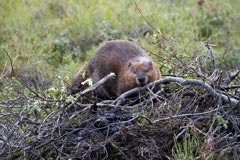Sherman Hollow, where I live, was undoubtedly originally made habitable to humans by beavers. The road now cuts through this valley and along the drainage that runs between steep hills. A series of level areas along this drainage are probably attributable to centuries of occupancy and work by beavers, and these areas are kept open by beavers to this day.
Centuries ago, these level areas would have been choice spots for setting up cabins: good places to live and hunt and to clear land for sheep and cattle grazing. People here still acknowledge the beavers’ proverbial industry (especially when they encounter a tree felled across our back road, or when a beaver dam breaks and washes the road out in a flash flood), but few feel indebted to them for creating the landscape in the first place.
Beavers are extraordinary rodents by almost any measure. Most famous, of course, are their logging skills, which could invite the envy of experienced ax-men. The trees these animals cut down with their chisel-like teeth may include the biggest in the forest, and they generally fall in a direction away from other trees that might hang them up. In this regard, beavers have a better batting average with their teeth than I do with my chainsaw, because chances are not all that remote that a tree I cut will get hung up in another tree, and I will then have a lot of work to get the first one to the ground. With beavers, I would guess that almost 90 percent of the time, the tree falls cleanly to the ground, and not only that, it usually falls directly toward or into their pond, which is exactly where it is best for them.
The reason for the beavers’ high success rate is probably simple: it’s a matter of choosing the right trees to cut. Hardwood trees naturally extend their branches toward the light, so as long as a beaver cuts the trees growing nearest to its pond, the tree will fall toward it since most of the branch weight will be on the pond side of the tree. Several of the trees beavers have felled along the edge of our road confirm this notion – they almost invariably fell in the direction in which they leaned, that is, directly across the road.
Beavers’ logging activity, combined with dam building, transforms the landscape. A beaver’s settlement usually starts humbly enough. A lone two-year-old, or perhaps a two-year-old mated pair, will discover an unclaimed piece of water. They’ll then erect a dam out of sticks, stones, sod, and mud. As the pond grows, the dam grows. As a family unit is established, the dam grows, or smaller dams are added downstream, and they can impound acres of pond where water levels are raised five or more feet. The results of their collective work, often performed over several generations, can be stunning. One beaver dam in Wyoming, though only 32 feet long, was 18 feet high. One on the Jefferson River in Montana measured 2,140 feet long.

see Tricks of the Trade, Spring 2004 issue.
Photo by Ken Thomas
There’s another logger-like aspect of beavers’ work: these “loggers” make and use roads. But unlike loggers, they also make canals. Making a road or canal to help transport wood from a distant area to where it’s needed in the pond may seem truly clever. What really happens, though, is probably less remarkable. Beavers normally drag branches to the water any which way they can, and after one drag over uneven ground, some vegetation is batted down, making it easier to again drag over the same ground. A few round trips, and a groove develops, and that’s where water then rushes down after it rains. Over many years, the water washes the soil away, and an ever-deepening groove develops, much as hiking trails on mountains can morph into seasonal brooks. In this way, beavers could create paths and canals simply by doing the easiest and simplest thing over and over, most likely without any forethought.
The work of beavers is most visible starting in November, when they are especially active. On brightly lit nights of the “Beaver Moon,” they busily prepare for winter by shoring up their dams and lodges. They’re also hard at work procuring winter food, cutting down more trees, limbing them, and dragging the branches to their pond. This food pile, which is stored in the deep water next to their lodge, serves as a food cache through the winter. Almost daily, I jog by the haunts of a pair of beavers that have just moved into an abandoned flowage (the original owners had been trapped out several years earlier due to a conflict over property rights of beavers versus people). I keep an eye on their progress.
The beavers’ winter preparations seem short, since they usually don’t commence until after the first frosts or after the leaves are down, which gives them little time before the ponds freeze over. This apparent delay until the last minute, however, is undoubtedly strategic: the timing ensures that the bark they will eat in the winter is kept as fresh as possible in the cold water of the late season. After the larder has been stocked, the beavers are often locked in under the ice for the entire winter, with their food supply – the bark on the branches – accessible under the water next to the lodge.
Beavers fell large trees to gain access to the branches at the top. They do this by chewing the tree’s trunk uniformly all around the base, devoting one or more nights to the task. The until gravity takes over and it topples.
It may seem like a lot of work to gnaw through the trunk of a tree two feet in diameter. But there is a big reward, for once a beaver has managed to fell the tree, it instantly has a great quantity of branches that provide first its winter food and then raw materials for home and dam construction. After the tree falls, the beaver chews off the branches, usually leaving the trunk to rot where it fell. If the tree is a preferred food species, such as the various members of the poplar family, the beavers may strip the bark from the trunk, too.
I’ve wondered if a beaver knows the reason for what it is doing when it cuts down a tree. Does it expect the large reward that it receives on completing its task? Or does it just chew through trunks, trusting to instinct?
An unplanned experiment with the beavers I have been watching in Sherman Hollow has given me some hints. It was in November 2007, and the new resident beaver (it could have been a pair, though I never saw two at the same time) at a new pond had chewed through the trunk of a big white birch, at the customary height of about a foot above the ground. This tree, however, hardly moved from its original vertical position even after the trunk was cut through, because its crown was braced on three sides by neighboring pines, which beavers never cut. This was an uncharacteristically poor choice of tree to tackle, and its trunk simply slid down off the stump rather than falling over.
To my great surprise, when I checked on the same tree several days later, I found there had been more work done on the tree. It was still standing, with a foot-long section of trunk on the ground next to it. The beavers had chewed through the trunk of the tree a second time, leaving it stuck in the ground on its sharpened point. I picked up the spindle-shaped piece of log and carried it home as a memento. It seemed like an interesting artifact of the beavers’ futile, if not foolish, industry. But as I soon learned, they were far from finished.
To my amazement, the beavers went back to the same tree again, and again, and again, and again, and again, and again (to be exact). I gathered seven stove-length pieces of log before a heavy frost put a lid of ice (on the night of 29 November) on the pond, ending the beavers’ work of providing me stove-length logs. Temperatures then dipped to 15° F below zero, and the beavers’ work did not resume until a sudden warm spell in the second week in January melted the snow and some of the ice. Immediately the beavers were at it again; they had insufficient food stores, in part because they had spent many nights chewing through that one birch tree that hadn’t ended up in their larder. By 12 January they had cut three more sections off the same birch that was still upright, but by this time, its diameter at the bottom had decreased from the original 10 inches to 6.5 inches. The next night, the beavers had removed yet another section.

Photo by Bernd Heinrich
I had originally presumed, after the first time the beaver cut clear through the trunk without the tree falling over, that the animal would realize the futility of chewing through it again. I was amazed that the beavers had repeated the same work 10 times on the same tree. It appeared that they had not made any mental connection between chewing through a tree and toppling it. It looked to me as if they operated on a program, one that amounted to the instructions: “Chew through vertical live tree stem. Period.”
Most trees require considerable effort to chew through, so the beavers are undoubtedly programmed for persistence, without regard for immediate gratification. Since most trees also fall immediately when severed from their stumps, nature would seem to be rewarding a beaver simply for being busy and persistent, and not for having knowledge and judgment of tree felling. Of course, in this particular case of the hung-up birch, after enough repeats of chewing through its trunk, the beaver would eventually reach the branches. But the beavers could not have known how much “wheel spinning” would be involved, and if they did eventually get something for their efforts, it seems to me likely that their reward would have been based less on reason and more on instinct.
The reward came when the tree finally fell over on 13 January, and the beavers immediately harvested all the branches at the top, cutting them off and dragging them to their lodge about 20 yards away. I noticed something curious, however: they also cut the now horizontal trunk five more times, but each time only about halfway through. And the cuts were the same distance apart as those on the previously vertical trunk had been. This work seemed even more futile than before, because the tree limbs with the bark that the animals wanted was already within easy reach. No more sections of trunk needed to be cut off to reach it, and in any case, cutting half-way through the tree trunk in several places accomplished nothing I could fathom.
I’ve never doubted the beavers’ industry, nor the efficiency of their sharp incisors. Their collective work, like that of bees, termites, and, indeed, people, incorporating the efforts of many individuals over many generations, is indeed impressive. But the fact that these beavers spent so much effort on this one hung-up tree when there were plenty of others available has me wondering just how clever they really are.


